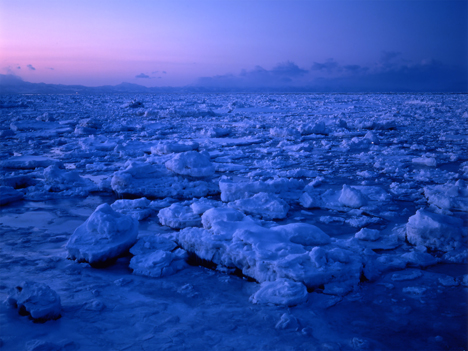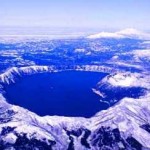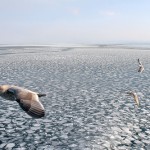知床Shiretoko

At the ‘end of the Earth’, fall unexpectedly into a lush, green paradise where brown bears, deer and red foxes abound, while being surrounded by stoic mountains fiercely jutting towards the sky空高く平然とそびえる山々に囲まれ、ヒグマや鹿、キツネが生息する自然豊かなこの場所は、地球最後の楽園のようにも感じられる。揺らめく流氷に優しく覆われた、その永遠に続くかのような海の景色が広がるその場所が、日本の北の果て「知床」だ。その豊かで稀少な動植物の生息する知床は、2005年7月、世界自然遺産に登録された。
![]()
“大地の果て”、“大地の突き出たところ”を意味するアイヌ語「シレトク」から由来している知床は、文字通りオホーツク海に突き出した地形をしている。知床は、そのほとんどのエリアが、徒歩かボートでしかアクセスできない故に、荒々しくも美しい自然の光景を発見できる数多くのチャンスがある場所だ。また、日本における最大のヒグマ生息地としても有名。知床を囲むのは北半球で最も低い緯度に位置しているオホーツク海。冬には、息を呑むほどの流氷を見ることができ、沿岸からは、オジロワシ、アザラシ、イルカ、クジラを発見することもある。
![]()
知床のおすすめスポットのひとつに、カムイワッカ湯の滝がある。「カムイワッカ」はアイヌ語で神の水という意味。知床の奥地に潜むその秘湯へのアクセスは、夏季のみ知床自然センターからシャトルバスで50分ほど(往復1,180円)。道路から約100メートルに位置する通称「一の滝」と呼ばれる区間では、温泉水温30度の川登りが楽しめる。しかし残念ながら現在は、落石防止工事のため車両の乗り入れは規制されている。(2009年現在)
![]()
静かな自然を楽しみたいなら、知床半島の西側に位置する原生林に囲まれた知床五湖がおすすめ。5つの湖はそれぞれ徒歩圏内に隣接し、一周できる遊歩道があるので1時間程で巡ることができる。また、知床半島西側のウトロと東側の羅臼を結ぶ道路の中間地点にある知床峠に立ち寄るのもいいだろう。羅臼岳の素晴らしい景色のほか、天気の良い日は北方領土の国後島を望むことも可能。また、知床五湖エリアには岩尾別温泉があり、露天風呂でリラックスしてのんびり過ごすこともできる。
![]()
知床は手付かずの自然を残しているので、一般の交通は厳しく規制されている。最寄りの駅はJR知床斜里駅。ここからシーズンピーク時に1日3便のバスを利用し、ウトロや知床半島の西沿岸へのアクセスが可能。また、東側からは羅臼を経由して知床へのアクセスも可能。羅臼までは、釧路からバスで3時間半ほど。他に夏期はウトロからも一日に2便のバスがある。
![]()
Text: Bonnie Oeni
Translation: Asami Miyamura, bringing the earth seemingly closer to heaven. And then, together with a view of the sea that stretches out into infinity, covered gently in shimmering ice, fall unexpectedly in love with Shiretoko, one of the most remote regions in Japan, also a designated UNESCO World Natural Heritage site for its luxuriant flora and fauna in 2005.
![]()
As the Ainu name suggests, this peninsula in eastern Hokkaido marks the ‘end of the land’, and sticks out into the Sea of Okhotsk. For those looking to reconnect with nature, the wilderness of Shiretoko offers plenty of opportunities to discover the rugged beauty of nature’s spectacles, since most of Shiretoko is only accessible on foot or by boat, and is famous for being home to Japan’s largest brown bear population. In winter, though you’ll have to brave the harsh weather, breathtaking ice floes can also be seen on the sea, as Shiretoko is located on the lowest latitude in the northern hemisphere. From the coastline, you’ll be able to spot sea eagles, seals, dolphins, porpoises and even whales!
![]()
Possibly the most rewarding and exciting experience you’ll have in Shiretoko is a visit to the Kamuiwakka Falls, which means ‘river of the gods’ in the Ainu language, and lives up to its name. Tucked deeply in the quietest corners of Shiretoko, access is solely through shuttle bus (round ticket 1,180 yen / runs only summer season) from the Shiretoko Shizen Center, and the 50-minute bus ride will take you through the heart of nature up a bumpy dirt 11km road. You will be able to clamber up the 30-degree Celsius slippery river for about 100 meters. (As of 2009, due to the construction work, the road to Kamuiwakka is closed to private vehicles.)
![]()
For some quiet time with nature and a more serene way of appreciating it, head to the Shiretoko Five Lakes, tucked at the end of the main road on the western coast, but which are more accessible. Located within walking distance of each other by well-kept trails, making a circuit around the five lakes should only take about an hour. You’ll feel your restless heart slowly winding down to a still peace as you gaze at the picturesque scenery, and feel a harmonious affinity with nature. Along the way, stop by the Shiretoko Pass, the highest point of the road connecting the western and eastern coasts, which yields fantastic views of Mt. Rausu and, on a good day, the Kunashiri Island. After a long hike, taking a dip and relaxing in the pleasant Iwaobetsu Onsen open-air hot springs would be the perfect way to end your day.
![]()
Since Shiretoko is a pristine natural habitat, public transport to Shiretoko is extremely limited. The nearest train station is Shari, where you can catch irregular buses (3 per day in peak season) through Utoro to the western coast of the peninsula. You can also opt to enter Shiretoko through the east, via the small town of Rausu, which can be reached by bus from Kushiro (3.5 hours) and two daily buses from Utoro. The Utoro option, however, is limited to the summer.
![]()
Text: Bonnie Oeni


